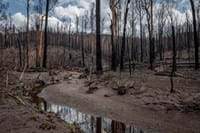Photo Credit: Doug Gimesy
Australian Government - Regional Bushfire Recovery for Multiregional Species and Strategic Projects Program.
Target species detection, impact assessment
Conservation
South-eastern Australia experienced devastating bushfires during the summer of 2019/20 with over 11 million hectares burnt including 13.56% of total platypus habitat (UNSW unpublished data). EnviroDNA and Cesar Australia were funded through the Australian Government Regional Bushfire Recovery for Multiregional Species and Strategic Projects Program to quantify the potential impacts on platypuses in NSW using landscape-scale occupancy data. Gathering occupancy data on platypuses at a landscape-scale is notoriously difficult using traditional survey techniques due to their low density, broad distribution and nocturnal nature.
Using eDNA, this project sought to increase the scope of available occupancy data with a systematic survey design. Sites were selected in burnt (impacted) and unburnt (control) areas throughout NSW to provide broad spatial coverage. In-kind contributions of data from several collaborators were also leveraged as well as previous eDNA survey data that provided an invaluable pre-fire and early post-fire dataset on platypus occupancy for a subset of sites in southern NSW (McColl-Gausden 2022). In total, 716 eDNA surveys were undertaken at 631 unique sites across 113 hydrobasins from September 2021 to October 2022.
Platypus DNA was detected at 232 sites (32%) with a further 128 sites (18%) returning possible detections. There were no detections of platypus DNA at 356 sites (50%). Detections of platypus DNA were recorded in 60 of the 113 hydrobasins surveyed. Occupancy rates in 2021/22 were similar between burnt and unburnt sites. However, more rigorous analysis of the subset of sites with pre-fire data showed a decline in platypus occupancy of ~10% post-fire compared to unburnt control sites.
Despite large areas of suitable platypus habitat affected by the 2019/20 megafires, and more recently widespread and severe flooding, platypuses remain widespread throughout the study area. This study demonstrates the importance of rigorous survey design, including pre-fire data and controls, on the outcomes of such investigations. Importantly, this project is the first to systematically investigate platypus occurrence at a landscape scale in NSW and provide an invaluable baseline against which to quantify future changes.
To learn more, we hosted a webinar sharing the findings including a Q&A discussion.
This project was funded by the Australian Government through the Regional Bushfire Recovery for Multiregional Species and Strategic Projects Program. EnviroDNA and Cesar Australia gratefully acknowledge the in-kind contribution of platypus eDNA survey data from the following organisations:
- NSW National Parks and Wildlife Service through a project supported by the Australian Government’s $200 million Bushfire Recovery for Wildlife and their Habitats.
- Jaliigirr Biodiversity Alliance through projects funded by Australian Government’s Bushfire Recovery for Wildlife and Habitat Community Grants Program and the Coffs Harbour City Council Environmental Levy program.
- Blue Mountains City Council through an internally funded project.
- NSW Department of Planning and Environment – Water, Wetlands and Coastal Science branch with collaboration and funding from National Parks and Wildlife Services – Kosciusko National Park.
- Wildlife Preservation Society of Queensland through a project supported by the Australian Government’s Regional Bushfire Recovery for Multiregional Species and Strategic Projects Program.
We also acknowledge the various organisations that granted permission to screen their relevant eDNA samples from other projects for platypuses or collected samples to be used by this project – NSW Department of Primary Industries, NSW Department of Planning and Environment, OzFish, Clarence Landcare via The Resilient Clarence Project funded by the NSW Government’s Bushfire Community Recovery and Resilience Fund, Austral Research and Consulting, Tamielle Brunt, EcoLinx, Western Sydney University, Jenolan Caves, and Border Ranges Alliance. Thank you also to the citizen scientists who volunteered their time to assist.
References
McColl-Gausden E. F. (2022) Environmental DNA sampling as a tool for monitoring freshwater vertebrates. PhD thesis. The University of Melbourne.

